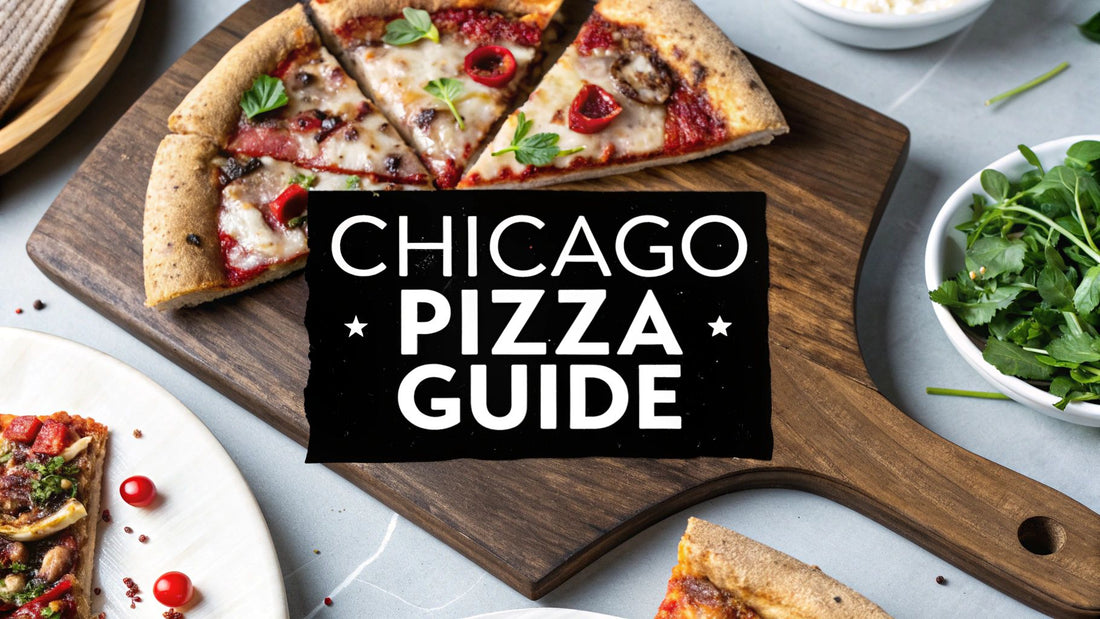
Your Ultimate Guide to Chicago Pizza
Share
When you hear “Chicago pizza,” your mind probably jumps straight to a towering, thick-crusted beast served steaming in a deep pan. And while deep-dish is without a doubt the city's most famous culinary export, that's just one chapter in a much bigger, more flavorful story for the city's iconic pizza restaurants.
What Really Defines Chicago Pizza
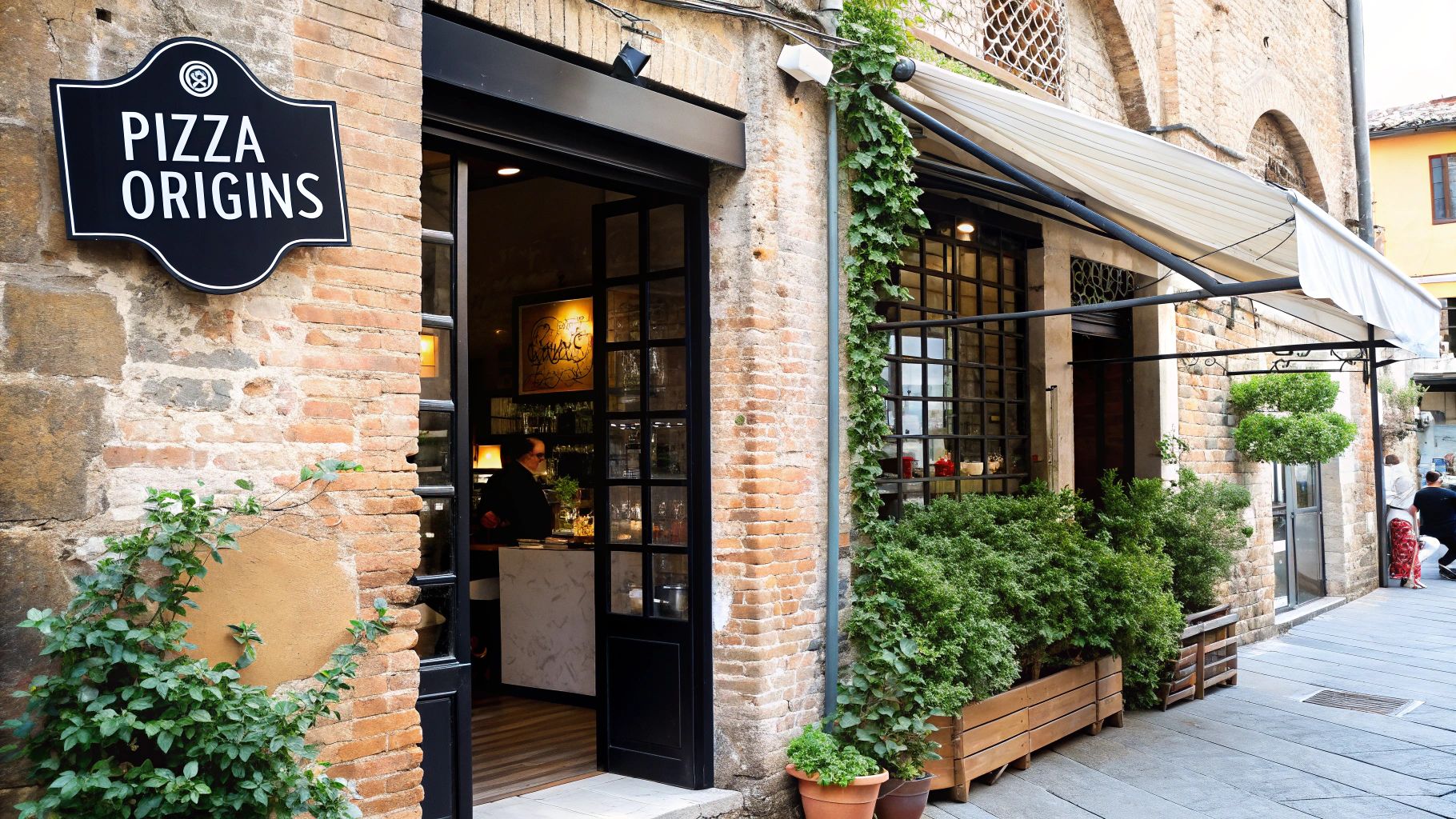
The true soul of Chicago pizza isn't found in a single recipe. It’s in the incredible variety. The city is a stage for three totally distinct pizza traditions, each with its own history, its own method of construction, and its own army of die-hard fans. Getting to know these three pillars is the first step to truly appreciating what Chicago brings to the pizza world.
This diversity has a massive impact on how a pizza restaurant actually runs its kitchen. The specific equipment, the prep-line workflow, and even the vibe of the place are all dictated by the style of pie on the menu. The journey from a ball of dough to a finished slice looks completely different for each one, starting with the pizza prep table.
The Three Pillars of Chicago Pizza
The entire Chicago pizza scene is built on three foundational styles. And trust me, each one demands a unique approach to everything from making the dough to baking the pie—and especially the commercial equipment you use in the kitchen.
- Deep-Dish Pizza: This is the iconic pie that tourists flock to at famous pizza restaurants like Lou Malnati's. It’s famous for its high, buttery crust, a clever inversion of cheese-then-sauce, and an almost unbelievable amount of fillings.
- Stuffed Pizza: Often confused with deep-dish, this version is somehow even more over-the-top. Popularized by chains like Giordano's, it starts with a bottom crust, gets a massive layer of cheese, and then is sealed with another paper-thin layer of dough before the sauce goes on top.
- Tavern-Style Pizza: This is the pizza the locals swear by. It features a cracker-thin, impossibly crispy crust, is loaded with toppings from edge to edge, and is always—always—cut into small, shareable squares. You'll find this at beloved neighborhood pizza restaurants like Vito & Nick's.
The real secret to running a successful Chicago pizza restaurant is understanding that you're not just making pizza; you're honoring a specific tradition. The right pizza prep table for a high-volume Giordano's churning out stuffed pies is completely different from what a neighborhood tavern-style joint like Vito & Nick's would need.
The Role of Pizza Prep Tables
This is exactly where having the right equipment becomes non-negotiable. A high-quality pizza prep table is the heart of any professional pizzeria, serving as the central command station for pie assembly. These refrigerated tables keep all your ingredients—cheese, meats, veggies—perfectly chilled and within arm's reach, guaranteeing both food safety and kitchen efficiency.
For deep-dish and stuffed pizza operations, your prep tables need massive refrigerated wells to hold pounds and pounds of mozzarella and deep containers for chunky tomato sauce. A tavern-style spot, on the other hand, would benefit more from a longer table with a whole bunch of smaller topping containers, set up for speed and customization.
This guide will break down how each unique style of Chicago pizza influences everything from the dough recipe right down to the essential equipment needed to make it perfect.
The Story Behind Chicago's Famous Pizza Styles
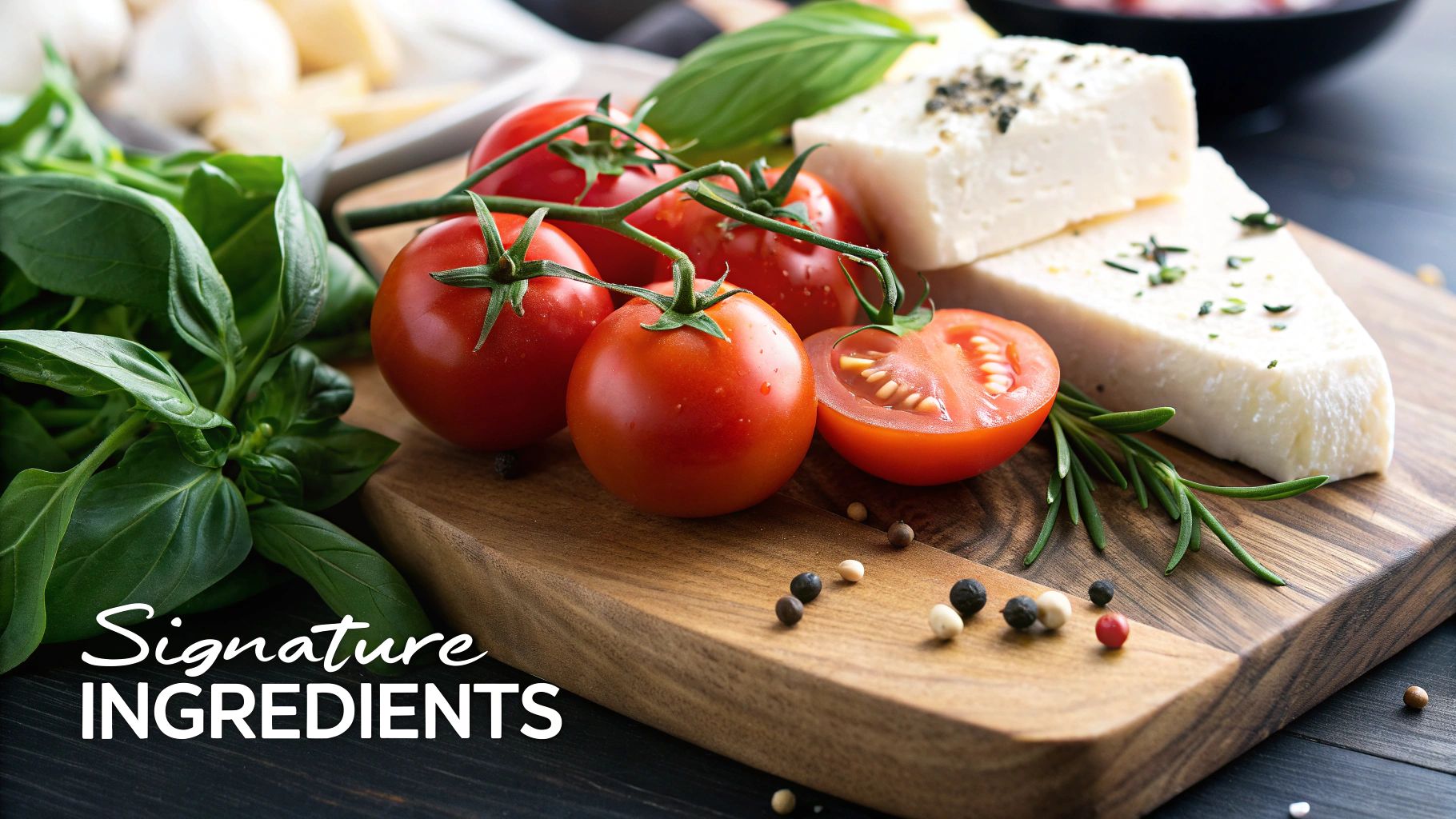
To really get Chicago pizza, you have to look past the ingredients. You have to go back to the late 19th and early 20th centuries, when waves of Italian immigrants made their way to the city, bringing their incredible food traditions with them. They built close-knit neighborhoods that laid the groundwork for a pizza revolution nobody saw coming.
Those early Italian-American kitchens and bakeries were where Chicago first got a taste of the simple, rustic flatbreads that were the ancestors of today's pizza. It wasn't the pizza we know now, but it was a start. It got the city primed and ready for something new, something that would become its most famous dish. The stage was set for the first dedicated pizza restaurants.
The Birth of a Legend: Pizzeria Uno and Deep-Dish
The big bang of Chicago pizza history happened in 1943. In a city humming with wartime energy, Pizzeria Uno introduced something totally different. This wasn't just another flatbread. It was a monster of a pie, with a thick, buttery crust baked in a high-sided pan.
This new style, deep-dish, flipped the traditional pizza script entirely. The mozzarella went down first, right on the dough, followed by the toppings. Then, a generous layer of chunky tomato sauce was ladled over the top. This genius move kept the cheese from burning during the long bake needed to cook that massive crust. It was an instant hit, and it gave pizza a whole new identity in the city.
The growth was nothing short of explosive. Invented at Pizzeria Uno, the deep-dish pie was a huge shift, with its thick crust and deep pans built to hold mountains of cheese and toppings. As post-WWII America got into rock 'n' roll, pizza became a Chicago staple. A 1953 Chicago Daily Tribune article captured the craze, noting that while there were almost no pizzerias in the city just 16 years earlier, over 100 existed by then. You can read more about Chicago's fascinating pizza history and its cultural impact.
The Next Evolution: Stuffed Pizza
Decades after deep-dish staked its claim, a new challenger stepped into the ring in the 1970s. Bold pizzaiolos at pizza restaurants like Nancy's and Giordano's looked at deep-dish and basically asked, "How can we make this even crazier?" Their answer was stuffed pizza.
Stuffed pizza takes the deep-dish concept and adds another layer of dough—a paper-thin sheet placed over the cheese and toppings. This top layer is sealed to the bottom crust, creating a pocket before it’s all smothered in sauce.
The result is a pizza with a truly staggering amount of cheese sealed inside, creating a molten core of gooiness that stretches for what feels like miles. This innovation forced pizza restaurants to rethink their kitchens, requiring even deeper pans and bigger pizza prep tables to handle the sheer volume of ingredients.
The Working-Class Hero: Tavern-Style Pizza
While deep-dish and stuffed pizzas were becoming postcard-famous, another style was quietly winning the hearts of Chicago's neighborhoods. Tavern-style pizza is the city's unsung hero, born out of working-class bar culture. It was designed to be a simple, cheap snack to keep patrons happy at local establishments.
- Designed for Sharing: The pizza was cut into small squares—"party cut"—making it perfect for a group huddled around a bar table.
- Easy to Handle: Its cracker-thin, crispy crust was sturdy enough to hold in one hand, leaving the other free for a cold beer.
- Salty and Satisfying: The salty toppings were a clever way to encourage folks to order another round, making it a brilliant business move for local taverns.
This no-nonsense, community-focused pizza is the one real Chicagoans swear by. It represents a different side of the city—less about towering architecture and more about neighborhood pride. Many of the city's oldest pizza restaurants are famed for their tavern-style pies.
Anatomy of Deep-Dish and Stuffed Pizza
To really get what makes a Chicago pizza tick, especially the deep-dish and stuffed kinds, you have to think of it less like a pizza and more like a delicious work of architecture. This isn't just about slapping some dough, sauce, and cheese together. It's a careful, layered construction, a savory pie built from the ground up inside a high-sided pan.
The whole journey starts with the crust. A serious amount of dough, usually made rich with butter or corn oil, gets pressed firmly into a well-seasoned, deep metal pan. This doesn't just form the bottom; it creates the high walls that have to contain the mountain of fillings that are about to go in. You're aiming for a crust that’s both flavorful and sturdy enough to stand up to everything without getting soggy.
With the foundation in place, the most critical—and for many, the most surprising—step comes next. Unlike just about any other pizza out there, the very first thing that goes inside the crust is a thick blanket of low-moisture mozzarella cheese. We're not talking a light sprinkle here. It's a solid, wall-to-wall layer that can be up to an inch thick. This "upside-down" construction is the secret to true deep-dish magic.
The Art of Layering
Once the cheese is down, it's time for the toppings. Things like sausage, pepperoni, mushrooms, and green peppers are placed right on top of that cheese layer. This strategic order is key—it protects the cheese from burning during the long, slow bake, which can take anywhere from 30 to 45 minutes. The sauce is always, always the last thing to go on, like a crown on top. It's usually a chunky, uncooked tomato sauce that's simply seasoned, allowing it to cook down and reduce right in the oven.
While deep-dish pizza is an absolute icon, its own history has a few layers. Pizzeria Uno's Ike Sewell usually gets all the credit, but if you dig a little deeper, it seems his partner, Ric Riccardo, was a huge part of nailing down the recipe. The real innovation was that high-edged pan, which created the perfect vessel for the massive amounts of cheese and toppings that made this Chicago pizza famous. You can get more of the story on the true origins of deep-dish at RealDeepDish.com.
For pizza restaurants that specialize in this style, a smooth workflow is everything. The whole assembly line needs to be perfectly organized on a dedicated prep station. You can take a look at our guide on how to choose the best prep tables for your restaurant to see just how much the right layout can impact your speed and quality.
What Makes Stuffed Pizza Different
Just when you thought a pizza couldn't get any more intense, stuffed pizza walks into the room. It starts out a lot like its deep-dish cousin, with a thick crust pressed into the bottom and up the sides of the pan. But after all the cheese and toppings are piled high, the game changes completely.
A second, paper-thin layer of dough is stretched over the top of the fillings and sealed to the bottom crust. This creates an enclosed "stuffed" pie, with the sauce then ladled on top of this upper crust.
This extra dough layer basically creates an insane, gooey pocket of molten cheese, making it even denser and gooier than a deep-dish. It's an engineering marvel that somehow contains an almost unbelievable amount of mozzarella. The pizza prep tables at these pizza restaurants must accommodate space for this extra dough-stretching step.
The infographic below breaks down the basic process for making these Chicago classics, from dough all the way to the oven.
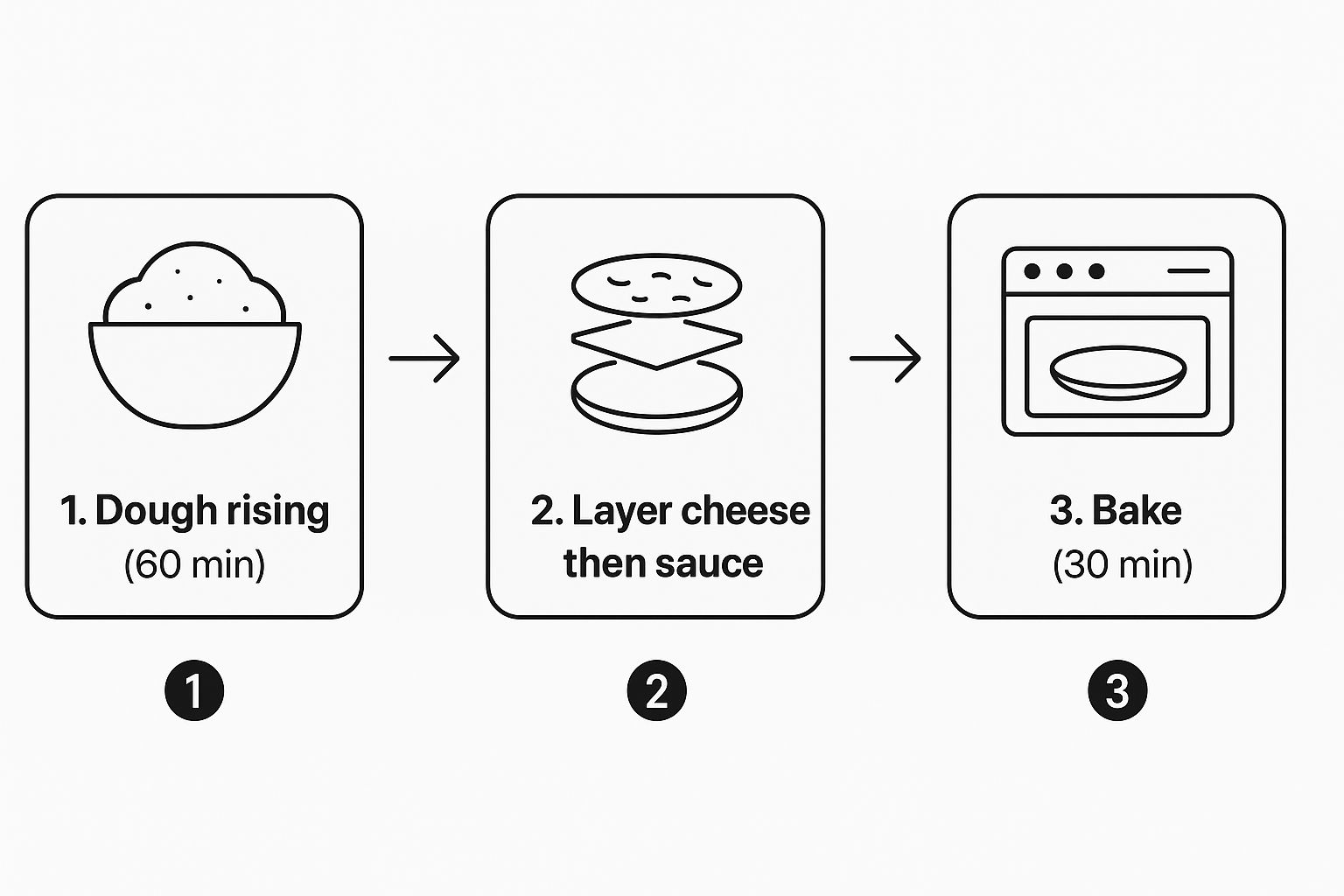
This simple flow really drives home the serious time commitment involved, which is why so many pizzerias will suggest you pre-order your pie. From rising the dough to the long bake, the whole process can easily take over an hour—a true testament to the care that goes into every single one.
Discovering Tavern-Style: The Pizza Chicagoans Truly Eat
When tourists flock to O'Hare with deep-dish pizza boxes tucked under their arms, they're missing out on the real deal. In the city's neighborhoods, a different kind of pizza is king. It’s tavern-style Chicago pizza—the unsung hero that fuels family gatherings, game nights, and casual evenings at the corner bar. This is the authentic taste of local life, served up at the city's most beloved pizza restaurants.
First, forget everything you think you know about Chicago pizza. Tavern-style is the complete opposite of its more famous cousin. It all starts with a dough that’s rolled impossibly thin, creating a cracker-like crust that’s shockingly crispy and sturdy. You won’t find any high, doughy walls here; this is a flat, crisp foundation built for pure flavor.
That unique crust is precisely why so many Chicagoans swear by it. It delivers a satisfying crunch without the heavy, bread-like feeling of deep-dish, which really lets the toppings shine.
Built for Bars and Community
The true genius of tavern-style pizza is baked into its history as the perfect bar food. It was designed from the ground up to be simple, shareable, and easy to handle with a drink in your other hand. This practicality shows up in its two most defining features.
First, the sauce and toppings are spread right to the very edge. No "pizza bone" or bland crust border exists here—every single bite is packed with flavor. Second is the signature "party cut" or "tavern cut," where the round pie is sliced into a grid of small squares.
This isn't just a quirky tradition; it's a social engineering masterpiece.
- It's Made for Sharing: Those small squares make it easy for a whole group to dig in without anyone having to commit to a giant slice.
- The Perfect Snack Size: You can grab a square or two for a quick bite or pile a few on your plate for a full-on meal.
- No Floppy Tips: The small, sturdy squares completely eliminate the dreaded pizza flop, making for a clean, one-handed eating experience.
For any pizza restaurant, getting tavern-style right means adopting a whole new kitchen philosophy. It’s a game of speed, precision, and absolute consistency. The assembly line is your best friend, and every single second counts.
The Tavern-Style Pizza Prep Table
Because tavern-style is all about rapid-fire assembly and lots of different topping combinations, the kitchen setup has to be a well-oiled machine. A standard pizza prep table for this style looks different from one built for deep-dish. It’s usually longer, with a refrigerated rail designed to hold a wide variety of smaller ingredient pans.
The workflow is pure, efficient motion. A cook can slide a thin crust down the line, slathering on sauce, cheese, and a medley of toppings from the chilled containers right in front of them. This setup allows a pizzeria to crank out a high volume of pies in no time, which is exactly what a busy neighborhood spot or bar needs. The entire focus is on a streamlined process that gets crispy, delicious pizza out to hungry customers without a long wait.
Choosing the Right Pizza Prep Table for Your Kitchen
For any serious Chicago pizza joint, the prep table isn't just another piece of stainless steel—it's the command center. This is where the magic happens. It’s where consistency is born, where speed is mastered, and where food safety is non-negotiable. A well-chosen pizza prep table is the engine that drives your entire kitchen, and it has a direct say in the quality of every single pie that hits the oven.
Think of it as the ultimate culinary workstation. It cleverly combines three critical functions into one efficient unit: a refrigerated base to keep dough and bulk ingredients perfectly chilled, a cooled top rail for instant access to toppings, and a durable work surface for assembly. The secret to an efficient pizza restaurant is knowing how these features serve the unique demands of each Chicago pizza style.
Matching the Table to the Toppings
First up, let's talk about the refrigerated rail, sometimes called the "cold wall." This is where you line up all your prepped toppings in individual pans. If you're specializing in classic Chicago pizza like deep-dish or stuffed, your ingredient needs are massive. You'll need a prep table that can handle deep, full-size pans to hold literal pounds of shredded low-moisture mozzarella, Italian sausage, and chunky tomato sauce.
A tavern-style pizzeria, on the other hand, lives and dies by variety and speed. Their ideal pizza prep table will have a longer rail designed to hold a whole bunch of smaller pans. This layout lets cooks quickly grab from dozens of different toppings—onions, olives, pepperoni, giardiniera—to build custom orders one after another.
The core principle is simple: your prep table's topping rail must perfectly mirror your menu. A deep-dish operation needs capacity and depth, while a tavern-style joint needs variety and accessibility.
The Importance of the Cutting Board and Work Surface
The work surface of a pizza prep table is where your pies come to life. It has to be tough, a breeze to clean, and—most importantly—big enough for your specific pizza. The industry standard is a high-density polyethylene cutting board that runs the full length of the unit.
For a deep-dish or stuffed pizza kitchen, the depth of this work surface is everything. Your team needs plenty of room to wrestle with those large, heavy pans, press in the thick crust, and carefully layer all those ingredients. A standard 19-inch deep cutting board is usually the bare minimum for these monsters.
Tavern-style operations have different needs. While they don't need as much depth, they benefit immensely from a longer, continuous work surface. This allows multiple cooks to work side-by-side, sliding the thin crusts down an assembly line from saucing to topping to the oven peel. That linear workflow is absolutely essential for the high-volume output that makes tavern-style pizza restaurants so successful.
Refrigerated Storage and Kitchen Footprint
Tucked beneath the work surface is the refrigerated base, the unsung hero of the prep table. This is where you keep your proofed dough balls, backup containers of toppings, and other essentials that need to stay cold. The size of this base is directly tied to the overall length of the table.
A smaller pizzeria might get by with a 44-inch table, which gives you about 12 cubic feet of storage. But high-volume deep-dish spots? They'll likely need a 93-inch or even a 119-inch model, which provides over 30 cubic feet of cold storage to keep pace with demand.
Choosing the right size is a delicate balancing act between your kitchen's physical footprint and your projected output. Before you pull the trigger, it’s a smart move to review a comprehensive guide on selecting the right commercial kitchen equipment to make sure your investment lines up with your real-world needs.
To make it even clearer, here’s a breakdown of how different prep table features serve the two main types of Chicago pizza.
Pizza Prep Table Features for Different Chicago Styles
This table compares the ideal pizza prep table features based on the primary style of Chicago pizza you're making. It’s a quick way to see what matters most for deep-dish versus tavern-style.
| Feature | Deep-Dish / Stuffed Pizza Needs | Tavern-Style Pizza Needs |
|---|---|---|
| Refrigerated Rail | Fewer, deeper pans for high-volume items like cheese and sausage. | More, smaller pans for a wide variety of toppings. |
| Cutting Board | Extra depth (at least 19 inches) to handle large, heavy pans. | Extra length to create a multi-station assembly line. |
| Refrigerated Base | Maximum cubic footage to store bulk dough and ingredients. | Moderate storage, optimized for quick access and turnover. |
| Overall Size | Often requires larger units (67" to 93" or more) for capacity. | Can use smaller (44" to 60") or long, narrow models. |
Ultimately, the goal is to find a prep table that eliminates friction in your kitchen. It should make the process of building your signature Chicago pizza feel almost effortless, letting your crew work faster, safer, and with more consistency. It's an investment that pays you back with every perfect pizza that comes out of the oven.
A Food Lover's Tour of Iconic Chicago Pizza Restaurants
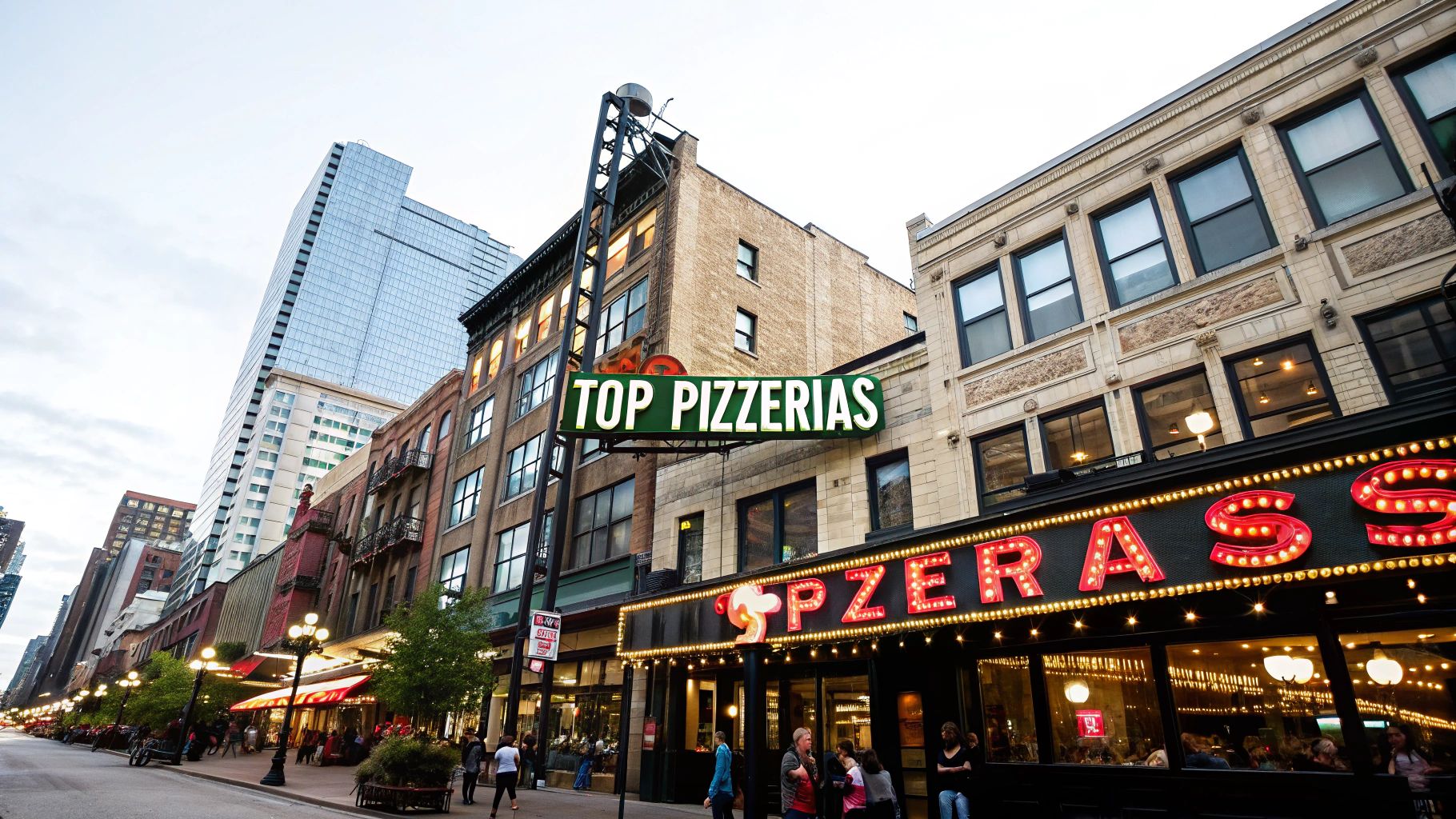
Alright, you know the history and you’ve broken down the anatomy of Chicago's legendary pizza styles. Now for the best part: eating it. The city is a minefield of legendary pizzerias, each with its own spin on tradition. This is your guide to the must-visit spots for an authentic taste of Chicago pizza, from the knife-and-fork deep-dish to the crispy, square-cut tavern-style.
This isn't just a tour for out-of-towners; it’s for anyone who wants to truly understand the soul of the city’s pizza restaurants. And make no mistake, behind the scenes, every one of these icons has a kitchen built around a pizza prep table—the command center where they craft their masterpieces with unbelievable speed and precision.
The Titans of Deep-Dish and Stuffed Pizza
When you’re after that classic, monumental Chicago pizza experience, a few names loom larger than the rest. These are the institutions that built their reputations on pies so thick and loaded they feel more like an event than a meal.
- Lou Malnati's Pizzeria: Famed for its proprietary Buttercrust™, Lou Malnati's serves a deep-dish that is impossibly rich yet surprisingly flaky. Their lean sausage patty, which covers the entire pizza from edge to edge, is the stuff of legend.
- Giordano's: If you're chasing the ultimate cheese pull, your pilgrimage ends at Giordano's. They are the undisputed masters of stuffed pizza, packing a jaw-dropping amount of mozzarella between two layers of crust for a pie that is pure decadence.
- Pequod's Pizza: For anyone who believes the best part of the pizza is the crispy, crunchy edge, Pequod's is a revelation. They’re famous for their "caramelized crust," a brilliant trick where they sprinkle a ring of cheese along the pan's edge, creating a dark, savory, and unforgettable border.
Each of these deep-dish giants has a distinct philosophy. Lou's is all about that buttery, flaky foundation. Giordano's bets the house on the cheese. And Pequod's worships at the altar of the crispy, caramelized edge. Hitting all three is a fantastic lesson in the subtle but critical variations of the deep-dish world.
The Authentic Taste of Tavern-Style
To eat like a real Chicagoan, you have to leave the tourist trail and dive into the neighborhoods for tavern-style pizza. This is the city's true comfort food: a cracker-thin, crispy crust, always cut into shareable squares. These beloved spots are often family-owned, serving their communities for generations.
A visit to one of these joints is a glimpse into the city's heart. You’ll find the atmosphere is just as crucial as the pizza—unpretentious, welcoming, and overflowing with local character. It’s a completely different kind of Chicago pizza experience, but one that is absolutely essential. For a wider look at notable pizzerias, you can explore our guide to top U.S. pizza restaurants nationwide.
Neighborhood Legends You Can't Miss
When locals start debating the best tavern-style pizza in Chicago, two names always surface. These are the pizza restaurants that have perfected the art of the cracker-thin crust and the signature "party cut."
Vito & Nick's Pizzeria
Tucked away on the South Side, Vito & Nick's is an institution. Walking in is like stepping back in time, with its old-school decor and a proud, no-frills attitude. The pizza arrives on a simple metal tray, with a crust so thin and crispy it audibly shatters with every bite.
Pat's Pizza
Another long-standing favorite, Pat's Pizza has been slinging its legendary thin-crust pies since 1950. The crust is famously delicate, providing the perfect canvas for their fresh toppings. It's a family-friendly spot that embodies the true spirit of the neighborhood pizzeria.
These restaurants are the soul of local Chicago dining. Their unwavering focus on a simple, perfectly executed product has earned them a fiercely loyal following that spans decades. When you visit, you aren't just getting a meal; you're taking part in a cherished local tradition.
Your Chicago Pizza Questions, Answered
Let's tackle some of the most common questions people have about Chicago-style pizza. Knowing the ins and outs will make your visit to any legendary pizza restaurant feel like you're a local.
First up, the big one: do you really need a fork and knife for deep-dish? Yes, you absolutely do! This isn't your average slice. With its towering crust, heavy layers of toppings, and a legendary amount of cheese, trying to eat it by hand is just asking for a mess. A fork and knife is standard practice and, frankly, the only civilized way to approach a true deep-dish or stuffed pie.
Ordering and Timing
Another question I hear all the time is about the wait. Just how long does it take to cook one of these things? You'll need to pack your patience. A real-deal, made-from-scratch deep-dish pizza needs a solid 30 to 45 minutes in the oven. That long, slow bake is essential to cook the dense layers all the way through without torching the cheese on top.
This is a pro tip straight from the source: because of the long bake, famous Chicago pizza spots like Lou Malnati's or Giordano's strongly suggest you pre-order your pizza. Call it in ahead of time, and it'll be hitting your table shortly after you sit down, letting you skip that long, hungry wait.
So, what's the actual difference between deep-dish and stuffed pizza? It all comes down to one sneaky, extra-thin layer of dough. A stuffed pizza is built with a bottom crust, loaded with cheese and toppings, and then sealed with another thin layer of dough on top before the sauce is ladled over.
A deep-dish, on the other hand, keeps it simpler with just the single bottom crust. The sauce goes directly onto the cheese and toppings. That one small difference is what makes stuffed pizza an even gooier, more cheese-forward experience—a critical distinction for any true pizza enthusiast.
At Pizza Prep Table, we arm restaurants with the durable, high-quality equipment needed to master any style of Chicago pizza. To find the perfect workstation that will streamline your kitchen and help you serve up consistently incredible pies, explore our full collection.
